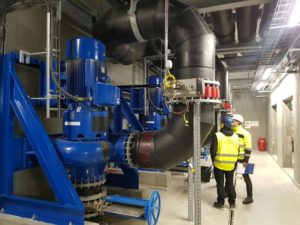Pumps and Solar Energy – A Feel-Good Movie, Not a Drama
Despite several setbacks, solar energy is ready for a happy end. Pumps for planned large-scale projects also have a leading role to play.
Deserts have more than enough sun. So far, though, mankind hasn’t been able to reap the benefits from it. Meanwhile, the proper steps have been taken, and parabolic mirrors are being adjusted: new solar power plants, like those in Morocco, are set to feed tremendous amounts of power into the grid. With Noor 1, one of the world’s largest solar plants has been opened, and many more will follow the plant located in the Moroccan city of Ouarzazate. Projects that are inconceivable without pumps.
The desert is alive – however, more or less in movies such as “Gladiator” and “Pope Joan”. The blockbusters were filmed in the craggy scenery Ouarzazate has to offer. Up until now, only the movies have been met with success. Everyday life in the Moroccan region is characterised by aridness and heat, two things that don’t promise too much joy. Thankfully, however, the script now needs to be rewritten, at least in parts, turning a drama to a feel-good movie.
Noor project generates 500 MW
The Noor solar project certainly is worthy of a leading role. An output of 160 MW will let it shine. With nearly 540,000 parabolic mirrors in 400 rows with a length of 300 metres each, the stage is also rather large. Further Noor projects are set to play further, important roles in the next few years. Morocco aims for power independence, without the need to import 90 percent of its primary energy anymore. Solar power is thus taking to the big screen.
By 2018, Noor I will supply more than one million households with solar power, while reducing CO2 emissions at the same time. After completion, the entire plant will cover an area spanning 30 square kilometres, generate a capacity of over 500 megawatts and supply around 1.3 million people with power. The total cost will be around 2.2 billion euro, according to plans.
Renewables on the rise
An enormous project – and also an enormous world market for solar power. Schroeder Valves confirms this. Solar power is a growth market, “because worldwide power supply has to move from fossil fuels towards renewables. It is sensible to use the sun and wind, as it always is worth it even with a low degree of efficiency,” explains Axel Mücher, owner and managing partner, Schroeder Valves. As such, Morocco is planning to increase the share of renewables to 42 percent by 2020. China is also driving growth for renewables, the country is aiming at a share of around 20 percent by 2030.
High willingness to invest
Thirst for energy and geographical location make some countries in Southeast Asia to lucrative markets for solar power. “We are experiencing a high willingness to invest also in countries such as Iran and Russia, thanks to current cash reserves,” states Mücher. Europa also is in focus. Spain is the country with the highest amount of solar thermal power plants. In the south of Spain, numerous such plants have been in operation for years, additional ones are being constructed and planned.
Most solar thermal power plants use parabolic trough technology to convert light into power. “Mirrors are used to focus sunlight on an absorber tube. The synthetic heat transfer fluid (HTF) in the tube is heated to 400 °C using the beam of light,” explains Mücher. This fluid creates steam over a heat exchanger, which drives turbines in the plant. “Our SSV valves are installed in the feed water circuit behind the pumps, and commonly operate at 170 bar and 180º C”. They are also installed in the HTF circuit, to protect the most important circulation pumps at 20 bar and 400° C. “The high level of reliability of the valves and the marginal pressure loss they guarantee are decisive importance in this process”.
Centrifugal pumps circulate heat transfer media
Solar thermal applications see heat transferred to media, for example water, oil and molten salts, which in turn makes the heat available to a different process. “This heat transfer medium needs to be circulated, for instance by centrifugal pumps, which are predestined to be protected by valves made by Schroeder Valves,” emphasises Axel Mücher.
Pumps play a demanding role in solar technology. “From our point of view, the high temperature level poses the greatest challenge, currently up to 400° C”. In comparison: water is heated to half as much, i.e. 200° C. Furthermore, the stress from varying temperature levels creates high requirements for materials and design. Mücher: “If the sun shines, it can become quite hot, if it doesn’t, things stay cold”.
Heliostat central tower a promising option
No question, manufacturing pumps for high-temperature applications require matching of materials, design and intelligent plant technology. Its application is worth it: “Solar power has great potential as a renewable and clean source of energy,” emphasises pump manufacturer Sulzer, too. The global demand for power is continuously increasing, while traditional energy sources are becoming scarcer and environmental concerns are rising.
Sulzer sees Heliostat central tower with direct steam generation as a promising option to create electricity from the sun. These plants focus sunlight on a heat exchanger mounted on a tower. “The system uses thousands of sun-tracking mirrors called heliostats to reflect the incident sunlight onto the receiver,” reports the pump manufacturer. In this case, water is used as the primary HTF, which is converted directly into steam.
Different pumps in operation
Feed water pumps, circulation pumps, condensate extraction pumps and cooling water pumps are used in Heliostat central tower plants. Feed water pumps feed water from the de-aerator through the HP heaters to the solar steam generator, explains Sulzer. Cooling water pumps make fresh water available, explains Sulzer, to cool exhaust steam from the condenser and pump it back into the wet cooling tower or the outlet of open cooling system.
Sulzer also sees Heliostat central tower with molten salt and heat storage as a further option. Feed water pumps are also used here, as well as condensate pumps, cooling water pumps, and molten salt circulation pumps.
Parabolic trough power plants
Parabolic trough power plants were extensively test at several sites in Spain, already in the 2000s. A parabolic trough is a sort of solar thermal energy collector. “It is constructed as a long parabolic mirror with a tube running its length at the focal point,” explains Sulzer.
In this variant, a part of the thermal oil used as primary heat transfer fluid is circulated through a heat exchanger where the heat is transferred to the molten salts circulating in a secondary circuit. Sulzer: “Heat is stored in a hot molten salt tank and can be released after the sun has gone down. This increases the operation time of the CSP plant by around six to seven hours”. The operating temperature is set to the thermal oil optimum of approximately 350º C, making steam generation with only a low flow rate possible.
Energy efficiency index
The market for solar energy continues to develop, innovations allowing higher efficiencies are in demand. Demand not only includes pump in industrial sizes, but also pumps for private households, which are increasingly becoming small solar power plants. Grundfos is one of the companies creating such innovations.
Ever since the exception rule ended on 1. August 2015, circulation pumps for solar applications are subject to the ErP directive, and are thus required to have an energy efficiency index (EEI) of 0.23 - at most. Fitted with electronically commutated motor (ECM) pumps and optimised hydraulics, all types of Grundfos’ new Alpha Solar range surpass these requirements. With an EEI below 0.20, the new Alpha Solar pumps possess one of highest levels of efficiency in their class, declares Grundfos.
High levels of efficiency
There is no end in sight to the boom of investments in solar power. Even despite the resounding defeat the planners behind the Desertec project experienced, which had originally been met with lots of enthusiasm. Back in 2009, twenty partners had founded the Desertec Trust with the goal of producing solar energy in the deserts of North Africa. The region was to be supplied with electricity, which was also supposed to be exported to South and Central Europe – 15 percent of Europe’s power demand was supposed to be covered.
The Desertec drama
Alas, the drama took its course. Owing to the unconvincing outlook all members exited the project in 2014, only three remained. This meant an end for Desertec, in its visionary scale. Today, three members of the Desertec Industrial Initiative keep the project running at a low level. However, the sun is set to rise after it has gone down. For there are numerous projects with bright prospects. Apart from the large-scale project in Ouarzazate, Morocco, South Korea is planning large-sized power plants in the Gobi Desert, and Japan in Mongolia. Chile is also keeping itself busy with a project modelled on Desertec.
A sunny happy end
The boom in solar energy will get a sequel worthy of the big screen: In 2016, new plants with a total output of 75 Gigawatt went online around the world, 19 Gigawatt more than in the previous year, reports German weekly “Der Spiegel”. According to a forecast provided by an international team of researchers published in “Science”, installed solar capacity will increase by at least the factor ten by 2030. As such, solar power is set to become a shining star, and face a happy ending.
Innovations and technologies in these fields can be found at Pump Summit Düsseldorf held parallel to Valve World Expo from November 27 – 29, 2018 at Düsseldorf Fairgrounds.
Source: Messe Düsseldorf GmbH







